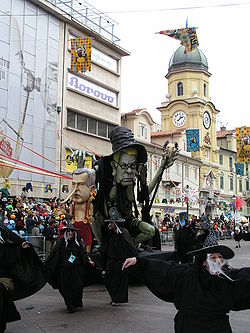
Rijeka Carnival
Encyclopedia

Lent
In the Christian tradition, Lent is the period of the liturgical year from Ash Wednesday to Easter. The traditional purpose of Lent is the preparation of the believer – through prayer, repentance, almsgiving and self-denial – for the annual commemoration during Holy Week of the Death and...
in Rijeka
Rijeka
Rijeka is the principal seaport and the third largest city in Croatia . It is located on Kvarner Bay, an inlet of the Adriatic Sea and has a population of 128,735 inhabitants...
, Croatia
Croatia
Croatia , officially the Republic of Croatia , is a unitary democratic parliamentary republic in Europe at the crossroads of the Mitteleuropa, the Balkans, and the Mediterranean. Its capital and largest city is Zagreb. The country is divided into 20 counties and the city of Zagreb. Croatia covers ...
. It is the biggest carnival
Carnival
Carnaval is a festive season which occurs immediately before Lent; the main events are usually during February. Carnaval typically involves a public celebration or parade combining some elements of a circus, mask and public street party...
in Croatia. In 2008 it celebrated its 25th anniversary.
History

Zvoncari
Zvončari is the characteristic folk custom maintained in the region around Rijeka, Croatia. Itt was added to UNESCO's Representative List of the Intangible Cultural Heritage of Humanity in 2009....
". All three groups have participated in the carnival each time since the beginning. The largest event happened in 2001 with 144 groups participating. Because of the restrictions that have been made regarding the number of participants in each group, the 2008 carnival had only 99 groups. Nonetheless, 150,000 visitors attended it.
Events
Every year there are numerous events preceding the carnival itself. First the mayor of Rijeka gives the symbolic key of the city to Meštar Toni, who is "the maestro" of the carnival, and he becomes the mayor of the city during the carnival, although this is only figuratively. Same day, there is an election of the carnival queen. As all the cities around Rijeka have their own events during the carnival time, Queen and Meštar Toni are attending most of them.Also, every year the Carnival charity ball is held in the Governor's palace in Rijeka. It is attended by politicians, people from sport and media life, as well as a number of ambassadors.
The weekend before the main event there are two other events held. One is Rally Paris - Bakar. (after the Dakar rally
Dakar Rally
The Dakar Rally is an annual rally raid type of off-road automobile race, organised by the Amaury Sport Organisation...
). The start is a part of Rijeka called Paris after the restaurant located there, and the end is in city of Bakar, located about 20 km south east. All of the participants of the rally wear masks, and the cars are mostly modified old cars. The other event is the children's carnival, held, like the main one, on Rijeka`s main walkway Korzo. The groups that participate are mostly from kindergartens and elementary schools, including groups from other parts of Croatia and neighboring countries.
The main event
The main carnival march is held on the last Sunday before the Ash WednesdayAsh Wednesday
Ash Wednesday, in the calendar of Western Christianity, is the first day of Lent and occurs 46 days before Easter. It is a moveable fast, falling on a different date each year because it is dependent on the date of Easter...
. It usually starts at noon. In the front there are the real mayor of Rijeka, the carnival Queen and Meštar Toni. The route of the march has several stages where the hosts present every group, and the main stage is situated in front of the city hall. The mayor, the queen and Meštar Toni stand in front of this stage and they greet all the groups coming afterward. The queen leaves this position only when the group, which she is originally from, pass the route of the carnival. Spectators usually gather to see the march all along its route. If the weather is good, up to 100,000 spectators may attend the carnival. Traditionally, the last group are Halubajski zvončari, and when they pass the march is over. Depending on the number of participants, this usually happens between 8 p.m. and 9 p.m.
Of course, the march does not mark the end of the carnival. On the same evening, there is an event called the burning of the Pust
PUST
PUST may refer to:*Pontifical University of Saint Thomas Aquinas, Rome, Italy*Pyongyang University of Science and Technology, Pyongyang, North Korea...
. Pust is a puppet, that has some satiric name, very often after some politician, and he is blamed for all the bad things that happened in the preceding year. This event is held in Rijeka harbor, and before he is taken to the sea, a reading of charges is held, where a spokesman reads all of his sins. Afterwards, a boat takes the Pust to the sea and it is burned there. This tradition is held in all places around Rijeka, but it is held on Tuesday or Wednesday after the carnival.
In the last few years there are several parties held on various locations in Rijeka, some starting day before the carnival, and end in the night after the carnival. The most known is a carnival party held on Korzo, where various DJs perform.

